Introduction
Introduction
Pelank Muscle © is proud to be your go-to, comprehensive scientific resource for understanding the anatomy and physiology of the human body’s muscles. We’ve worked hard to provide accurate, practical, and up-to-date information for everyone passionate about sports and fitness. This encyclopedia is designed to help you gain a deeper understanding of how your muscles work, how they’re grouped, and the vital role each muscle plays in various body movements.
From the muscles of your neck down to your lower limbs, this section of our site thoroughly explores every muscle group in the body. The information is meticulously sourced from highly reputable references, such as Gray’s Anatomy, and then simplified to be easily understandable for everyone, regardless of their scientific background.
Our Goal: Beyond Just Knowledge
Our aim isn’t just to share accurate knowledge; it’s also to provide practical solutions that help you improve muscle function, prevent injuries, and boost your overall physical capabilities. By studying and understanding the information in this encyclopedia, you’ll be well-equipped to effectively pursue your fitness goals and maintain your health.
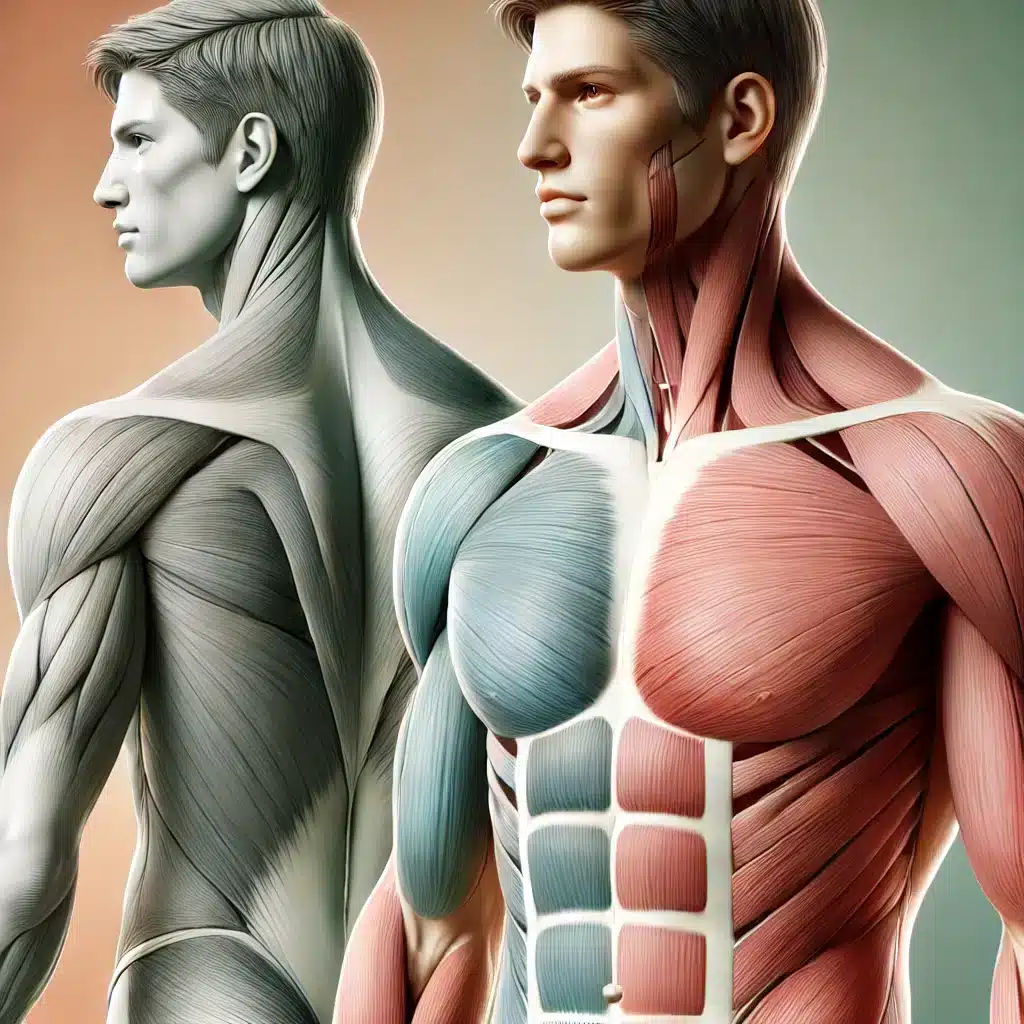
Introduction text
Basic Explanation
In this section, we’ve undertaken a comprehensive and detailed examination of all the body’s muscles. Our primary goal has been to identify the specific functions of each muscle, understand how they operate in various movements, and their crucial role in maintaining balance and strength throughout your body.
From the neck muscles, which play a vital role in stabilizing the head and preventing cervical injuries, to the muscles of the upper and lower limbs involved in strength and endurance movements, each group is examined separately. Every muscle is analyzed based on its anatomy and physiology so that you can gain a clearer understanding of how each contributes to the overall function of the body.
Our method involves studying and examining muscles in a categorized, grouped approach. We’ve divided them into major groups, such as the muscles of the torso, upper limbs, lower limbs, and neck. Within each of these categories, we’ve outlined their unique characteristics, functions, and specific strengthening exercises.
Furthermore, within the torso muscles, we’ve specifically analyzed all muscle groups individually, including the muscles of the chest, back, shoulders, and abdomen. We’ve even gone as far as to dissect and analyze each individual muscle within these sections.
This detailed process hasn’t been limited to just the torso muscles; it extends to other groups like the muscles of the arms, shoulders, back, abdomen, forearms, and even the lower limbs.
This means every single muscle and muscle group in the body has been precisely and individually examined. This thorough approach ensures you have highly accurate information about each muscle and its function in various bodily movements.
What’s more, we’ve used scientific insights to present all this information in an engaging and informative way. This means you can both enjoy learning and make the best use of this knowledge to enhance your physical performance.
Pelank Muscle © isn’t just about familiarizing you with detailed human anatomy; it also guides you toward performing exercises correctly and effectively.
Human muscle groups
Muscle Groups of the Human Body
Head and neck muscles
Muscles of the Head and Neck
✅ Facial muscles
📌 These muscles primarily control delicate facial movements, express emotions, and manage the opening and closing of the eyes and mouth.
🟩 Frontalis muscle
✔ Raises the eyebrows
🟩 Occipitalis muscle
✔ Pulls the scalp backward
🟩 Orbicularis Oculi muscle
✔ Closes the eyelids
🟩 Orbicularis Oris muscle
✔ Closes and puckers the lips
🟩 Levator Anguli Oris muscle
✔ Raises the corner of the mouth (smiling)
🟩 Levator Labii Superioris muscle
✔ Elevates the upper lip
🟩 Depressor Labii Inferioris muscle
✔ Lowers the lower lip
🟩 Depressor Anguli Oris muscle
✔ Lowers the corner of the mouth
🟩 Buccinator muscle
✔ Controls air in the mouth, compresses the cheek
🟩 Risorius muscle
✔ Pulls the corners of the mouth sideways (smiling)
🟩 Mentalis muscle
✔ Protrudes the lower lip (expressing doubt or displeasure)
🟩 Nasalis muscle
✔ Compresses or flares the nostrils
✅ Muscles of Mastication
📌 These muscles are responsible for jaw movement during chewing and speaking.
🟩 Masseter muscle
✔ The strongest chewing muscle, elevates the lower jaw
🟩 Temporalis muscle
✔ Retracts and elevates the lower jaw
🟩 Medial Pterygoid muscle
✔ Elevates and rotates the lower jaw
🟩 Lateral Pterygoid muscle
✔ Protracts and rotates the lower jaw
✅ Tongue Muscles
📌 These muscles are responsible for tongue movements during speaking, chewing, and swallowing.
🔹 The tongue muscles are divided into two groups: extrinsic muscles (which move the tongue) and intrinsic muscles (which change the shape of the tongue).
🔷 Extrinsic tongue muscles
- Genioglossus muscle
✔ Protracts the tongue - Palatoglossus muscle
✔ Elevates the tongue - Hyoglossus muscle
✔ Depresses the tongue - Styloglossus muscle
✔ Retracts the tongue
🔷 Intrinsic tongue muscles
- Superior Longitudinal muscle
✔ Shortens and elevates the tip of the tongue - Inferior Longitudinal muscle
✔ Shortens and lowers the tip of the tongue - Transverse muscle
✔ Narrows the tongue - Vertical muscle
✔ Flattens and broadens the tongue
✅ Muscles of the Pharynx & Swallowing
📌 These muscles play a key role in the swallowing process and the movement of food from the mouth to the esophagus.
- Palatopharyngeus muscle
✔ Elevates the pharynx - Stylopharyngeus muscle
✔ Elevates the pharynx during swallowing - Salpingopharyngeus muscle
✔ Elevates the pharynx and the middle ear cavity - Pharyngeal Constrictor Muscles
✔ Assist in the movement of food:
-
Superior Constrictor muscle
-
Middle Constrictor muscle
-
Inferior Constrictor muscle
✅ Laryngeal Muscles
📌 These muscles control the vocal cords and regulate voice production.
🔹 They have two main groups: intrinsic muscles (which control the vocal cords) and extrinsic muscles (which move the entire larynx).
🔷 Intrinsic Laryngeal Muscles
- Cricothyroid muscle
✔ Stretches the vocal cords to produce sound - Thyroarytenoid muscle
✔ Shortens the vocal cords - Vocalis muscle
✔ Fine-tunes the vibration of the vocal cords - Transverse and Oblique Arytenoid muscles
✔ Close the vocal cords
✅ Anterior & Posterior Neck Muscles
📌 These muscles control the movement of the head and neck and support the cervical structures.
🔷 Anterior Neck Muscles
- Sternocleidomastoid muscle
✔ Rotates and flexes the neck - Strap Muscles
✔ Support and movement of the larynx
Sternohyoid muscle
Thyrohyoid muscle
Sternothyroid muscle
🔷 Posterior Neck Muscles
- Upper Trapezius muscle
✔ Elevates and rotates the head and shoulder - Deep Neck Flexors
✔ Support the cervical vertebrae
✅ Deep Neck Muscles | Scalene & Longus Muscles
📌 These muscles are located in the deeper layers of the neck and are responsible for stabilizing and finely controlling movements of the cervical vertebrae.
🔷 Deep Anterior Neck Muscles
- Rectus Capitis Anterior muscle
✔ Flexes the head forward - Rectus Capitis Lateralis muscle
✔ Laterally flexes the head - Longus Capitis muscle
✔ Flexes the head forward and stabilizes the neck - Longus Colli muscle
✔ Flexes and stabilizes the cervical vertebrae
🔷 Deep Posterior Neck Muscles
- Obliquus Capitis Superior muscle
✔ Rotates and laterally flexes the head - Obliquus Capitis Inferior muscle
✔ Rotates the head to one side - Rectus Capitis Posterior Major muscle
✔ Extends and rotates the head - Rectus Capitis Posterior Minor muscle
✔ Stabilizes head movements
Trunk muscles
Muscles of the Trunk

Chest muscles | Thoracic muscles
💠 These muscles primarily play a role in respiratory movements and movements of the upper limbs.
| 🔸 Superficial chest muscles |
|
✅ Pectoralis Major muscle
✅ Pectoralis Minor muscle ✅ Subclavius muscle ✅ Serratus Anterior muscle |
| 🔸 Deep chest muscles |
|
✅ External Intercostal Muscles ✅ Internal Intercostal Muscles ✅ Innermost Intercostal Muscles ✅ Transversus Thoracis muscle ✅ Subcostal Muscles ✅ Diaphragm muscle |
📚 Further Reading
For a comprehensive study of the mentioned muscles and 20 practical tips about the chest muscle group, please visit the dedicated chest muscles page.
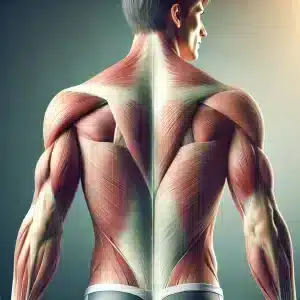
| Back Muscles
💠 The back muscles are divided into superficial and deep layers and are responsible for movements of the spine, shoulder, and rib cage.
| 🔸 Superficial back muscles |
|
✅ Trapezius muscle ✅ Latissimus Dorsi muscle ✅ Levator Scapulae Muscle ✅ Rhomboid Major Muscle ✅ Rhomboid Minor Muscle |
| 🔸 Intermediate back muscles |
|
✅ Serratus Posterior Superior Muscle ✅ Serratus Posterior Inferior Muscle |
| 🔸 Deep (Intrinsic) back muscles |
|
🔹 Superficial layer of the deep muscles ✅ Erector Spinae Muscles
🔹 Middle layer of the deep muscles ✅ Semispinalis muscle ✅ Multifidus Muscle ✅ Rotatores – Longus & Brevis Muscle 🔹Deep Layer of Deep Muscles ✅ Interspinales muscles ✅ Intertransversarii Muscle ✅ Levatores Costarum Muscle |
📚 Further Reading
For a complete study of the mentioned muscles and 20 practical tips about the back muscle group, please visit the dedicated back muscles page.
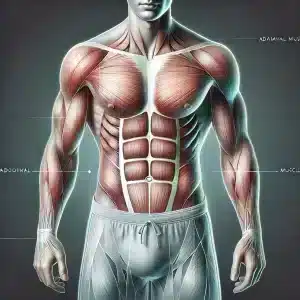
Abdominal Muscle
💠 These muscles are responsible for core stability, trunk flexion and rotation, and support of the internal organs.
| 🔸 Anterior abdominal muscles |
|
✅ Rectus Abdominis Muscle ✅ Pyramidalis Muscle |
| 🔸 Lateral abdominal muscles (Oblique muscles) |
|
✅ External Oblique Muscle ✅ Internal Oblique Muscle ✅ Transversus Abdominis Muscle |
| 🔸 Posterior abdominal muscles |
|
✅ Quadratus Lumborum Muscle |
📚 Further Reading
For a complete study of the mentioned muscles and 20 practical tips about the abdominal muscle group, please visit the dedicated abdominal muscles page.
| Pelvic Floor Muscles
💠 These muscles are responsible for supporting the pelvic organs and controlling urinary and fecal functions.
| 🔸 Pelvic diaphragm muscles |
|
🟩 Levator Ani
🟩 Coccygeus |
| 🔸 Perineal muscles |
|
🟩 Superficial Transverse Perineal 🟩 Deep Transverse Perineal 🟩 External Anal Sphincter 🟩 External Urethral Sphincter 🟩 Bulbospongiosus 🟩 Ischiocavernosus |
📚 Further Reading
This information about these muscles is provided for your general knowledge.
Upper limb muscles
Muscles of the Upper Limb
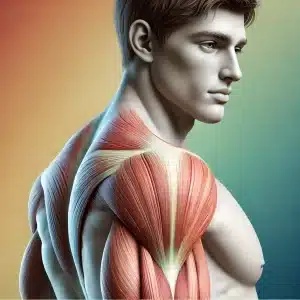
Shoulders Muscles
💠 This group includes muscles that control the movement and stability of the shoulder joint. Both superficial and deep muscles are part of this section.
| 🔸 Superficial shoulder muscles |
|
✅ Teres Major Muscle ✅ Deltoideus Muscle
|
| 🔸 Deep shoulder muscles |
|
🔹 Rotator Cuff Muscles ✅ Supraspinatus Muscle ✅ Infraspinatus Muscle ✅ Teres Minor Muscle ✅ Subscapularis Muscle |
📚 Further Reading
For a complete study of the mentioned muscles and 20 practical tips about the shoulder muscle group, please refer to the shoulder muscles page.
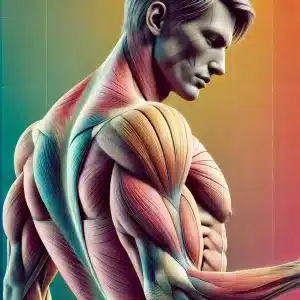
Arm Muscles
💠 This group includes muscles located between the shoulder and elbow, responsible for elbow movements and some shoulder motions.
| 🔸 Anterior muscles (biceps) |
|
✅ Biceps Brachii Muscle ✅ Brachialis Muscle ✅ Coracobrachialis Muscle |
| 🔸 Posterior muscles (triceps) |
|
✅ Triceps Brachii Muscle ✅ Anconeus Muscle |
📚 Further Reading
For a complete study of the mentioned muscles and 20 practical tips about the arm muscle group, please refer to the arm muscles page.
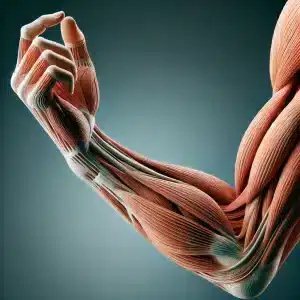
Forearm Muscles
💠 This group includes muscles located between the elbow and the palm, responsible for forearm movements and finger motions.
| 🔸 Flexor muscle group (anterior) |
|
✅ Pronator Teres Muscle ✅ Pronator Teres Muscle ✅ Palmaris Longus Muscle ✅ Flexor Carpi Ulnaris Muscle |
| 🔸 Deep anterior muscles |
|
✅ Flexor Digitorum Superficialis Muscle ✅ Flexor Digitorum Profundus Muscle ✅ Flexor Pollicis Longus Muscle ✅ Pronator Quadratus Muscle |
| 🔸 Extensor muscle group (posterior) |
|
✅ Brachioradialis Muscle ✅ Extensor Carpi Radialis Longus Muscle ✅ Extensor Carpi Radialis Brevis Muscle ✅ Extensor Digitorum Muscle ✅ Extensor Digiti Minimi Muscle ✅ Extensor Carpi Ulnaris Muscle |
| 🔸 Deep posterior muscle group |
|
✅ Supinator Muscle ✅ Abductor Pollicis Longus Muscle ✅ Extensor Pollicis Brevis Muscle ✅ Extensor Pollicis Longus Muscle ✅ Extensor Indicis Muscle |
📚 Further Reading
For a complete study of the mentioned muscles and 20 practical tips about the forearm muscle group, please refer to the forearm muscles page.
Hand Muscles
💠 This group consists of small muscles responsible for controlling finger movements.
| 🔸 Thenar muscles – control of thumb movement |
|
🟩 Abductor Pollicis Brevis 🟩 Flexor Pollicis Brevis 🟩 Opponens Pollicis 🟩 Adductor Pollicis |
| 🔸 Hypothenar muscles – control of the little finger movement |
|
🟩 Abductor Digiti Minimi 🟩 Flexor Digiti Minimi Brevis 🟩 Opponens digiti minimi muscle 📑 Opponens Digiti Minimi |
| 🔸 Midpalmar muscles |
|
🟩 Dorsal Interossei 🟩 Palmar Interossei 🟩 Lumbrical muscles |
📚 Further Reading
This information about these muscles is provided for your general knowledge.
Lower limb muscles
Muscles of the Lower Limb
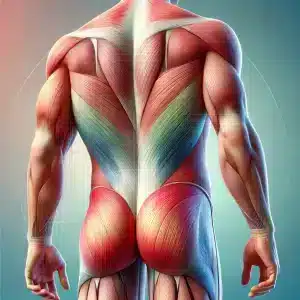
Muscle Groups of the Hip & Gluteal
💠 This group includes muscles responsible for hip joint movement and pelvic stabilization.
| 🔸 Superficial gluteal muscles |
|
✅ Gluteus Maximus Muscle ✅ Gluteus Medius Muscle ✅ Gluteus Minimus Muscle |
| 🔸 Hip and knee stabilizer muscle |
|
✅ Tensor Fasciae Latae – TFL Muscle |
| 🔸 Deep gluteal muscles |
|
✅ Piriformis Muscle ✅ Obturator Internus Muscle ✅ Obturator Externus Muscle ✅ Superior Gemellus Muscle ✅ Inferior Gemellus Muscle ✅ Quadratus Femoris Muscle |
📚 Further Reading
For a complete study of the mentioned muscles and 20 practical tips about the pelvic and gluteal muscle group, please refer to the pelvic and gluteal muscles page.

Thigh Muscles
💠This group includes muscles that control hip and knee joint movements. The thigh muscles are divided into three groups: anterior (flexors), medial (adductors), and posterior (extensors).
| 🔸 Anterior thigh muscles (quadriceps) |
|
✅ Sartorius Muscle ✅ Quadriceps Femoris Muscle
|
| 🔸 Medial thigh muscles (adductor muscles) |
|
✅ Adductor Longus Muscle ✅ Adductor Brevis Muscle ✅ Adductor Magnus Muscle ✅ Gracilis Muscle ✅ Pectineus Muscle |
| 🔸 Posterior thigh muscles (hamstring muscles) |
|
✅ Biceps Femoris Muscle ✅ Semitendinosus Muscle ✅ Semimembranosus Muscle |
📚 Further Reading
For a complete study of the mentioned muscles and 20 practical tips about the thigh muscle group, please refer to the thigh muscles page.
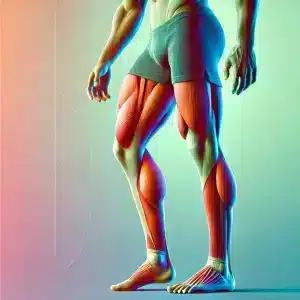
Lower Leg Muscles
💠 This group includes muscles that control movements of the ankle, knee, and toes. The calf muscles are divided into three groups: anterior (extensors), lateral (peroneal), and posterior (flexors).
| 🔸 Anterior calf muscles |
|
✅ Tibialis Anterior Muscle ✅ Extensor Digitorum Longus Muscle ✅ Extensor Hallucis Longus Muscle ✅ Fibularis Tertius Muscle |
| 🔸 Lateral calf muscles |
|
✅ Fibularis Longus – Peroneus Longus Muscle ✅ Fibularis Brevis – Peroneus Brevis Muscle |
| 🔸 Posterior calf muscles |
|
🔹 Superficial posterior muscles ✅ Gastrocnemius Muscle ✅ Soleus Muscle ✅ Plantaris Muscle 🔹 Deep posterior muscles ✅ Tibialis Posterior Muscle ✅ Flexor Digitorum Longus Muscle ✅ Flexor Hallucis Longus – FHL Muscle ✅ Popliteus Muscle |
📚 Further Reading
For a complete study of the mentioned muscles and 20 practical tips about the calf muscle group, please refer to the calf muscles page.
Foot Muscles
💠 This group includes muscles responsible for toe movements and foot arch stability.
| 🔸 Dorsal foot muscles |
|
🟩 Extensor Digitorum Brevis 🟩Extensor Hallucis Brevis |
| 🔸 Plantar foot muscles |
|
📌 These muscles are arranged in four layers: 🔹 First layer (the most superficial plantar muscles): 🟩 Abductor Digiti Minimi 🟩 Abductor Hallucis 🟩 Flexor Digitorum Brevis 🔹 Second layer: 🟩 Lumbricals 🟩Quadratus Plantae 🔹 Third layer: 🟩 Flexor Hallucis Brevis 🟩Adductor Hallucis 🟩 Flexor Digiti Minimi Brevis 🔹 Fourth layer (the deepest plantar muscles): 🟩 Dorsal Interossei 🟩Plantar Interossei |
📚 Further Reading
This information about these muscles is provided for your general knowledge.
References
Resources
Anatomy and medical books :
Gray's Anatomy (one of the standard references in anatomy)
Netter's Atlas of Human Anatomy (a well-known illustrated atlas in anatomy)
Clinically Oriented Anatomy by Keith Moore
Medical databases :
PubMed (for scientific and research articles)
MedlinePlus (health and medical information)
WebMD (for practical and general health information)
Sports and training references :
Strength Training Anatomy by Frederic Delavier
Essentials of Strength Training and Conditioning by NSCA
Well-known articles and training programs by international coaches
Medical databases :
PubMed (for scientific and research articles)
MedlinePlus (health and medical information)
WebMD (for practical and general health information)
Specialized sports and health websites :
Images used:
(Kenhub) kenhub.com
Pelank Life | Body Health Assessment
The Best Body Health Calculators Using Scientific Methods
Developed by Pelank Life ©